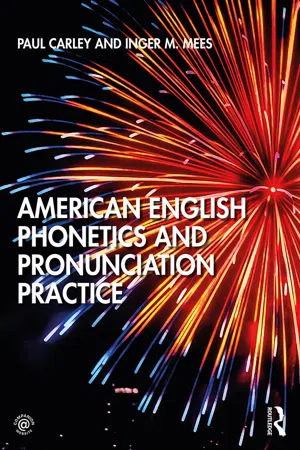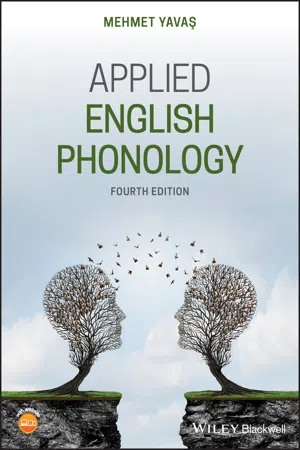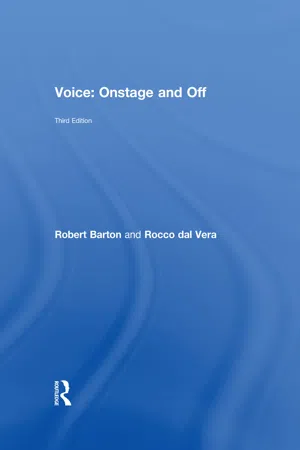Languages & Linguistics
Vowel Chart
A vowel chart is a visual representation of the vowel sounds in a language, typically displayed on a grid with the position of the tongue and lips. It helps linguists and language learners understand and compare the different vowel sounds in a systematic way. Vowel charts are used to analyze and describe the vowel systems of various languages.
Written by Perlego with AI-assistance
4 Key excerpts on "Vowel Chart"
- Paul Carley, Inger Mees(Authors)
- 2019(Publication Date)
- Routledge(Publisher)
Chapter 5Vowel theory
5.1 Describing vowelsWe saw in Chapter 2 that a consonant is a speech sound that involves an obstruction to the airstream on its way through the vocal tract. So what then is a vowel? A vowel is the opposite of a consonant: a sound made with no obstruction in the vocal tract to the air as it passes through it.Say a long /ɑ/, the sound doctors ask us to make when they want to look into our mouths, and feel how the air flows out through your mouth without any obstruction. Try the same for /i/, the <ee> of tree, and /æ/, the <a> of cat. You will notice that the lips and tongue take different positions for these different vowels, but in each case, there’s no obstruction or blockage of the kind that we find in consonants.If consonants are analyzed in terms of the kind of obstruction involved and where it is in the vocal tract, how can we analyze vowels, which have no such obstruction? Although the tongue and lips assume a wide range of complex shapes for the articulation of different vowels, a relatively simple system has been developed to describe them. Figure 5.1 shows the vowel diagram from the chart of the International Phonetic Association, which is based on this system of vowel description.5.1.1 Tongue shapeIn order to understand the system behind the diagram, the first step is to explore the limits of the range of tongue positions used to make vowels, known as the vowel space. There are two fixed articulatory reference points to the system. To find the first, you make a vowel with the front of the body of your tongue pushed as far forward and as far up toward the hard palate as possible. This is the position for the [i] vowel (see Figure 5.2 ). If you move your tongue any further forward or up, audible friction would result between the tongue and the hard palate, and the sound would no longer be a vowel. The second reference point is found by doing the opposite – opening your mouth and pulling your tongue as far down and back as possible without causing friction between the root of the tongue and the back wall of the pharynx (see Figure 5.3 ). This is the [ɑ] vowel. A further two positions can be identified by pushing the tongue as far up and back as possible (see Figure 5.4 ), which gives us the [u] vowel, and by pushing the tongue as far forward and down as possible (see Figure 5.5 ), which gives us the [a] vowel. Note that during the production of all these vowels, the tongue tip and blade (see Figure 5.6- eBook - ePub
- Patricia Ashby(Author)
- 2013(Publication Date)
- Routledge(Publisher)
6 Describing vowelsThis chapter discusses the way in which phoneticians describe vowel sounds, introducing the Cardinal Vowels and outlining the principal parameters of vowel quality variation. It compares vowels and consonants and establishes the vowel labelling system employed by phoneticians. Representations of vowels are explored, including waveforms and spectrographic images as well as impressionistic records (vowel diagrams, including the IPA Chart vowel diagram, and the use of diacritics in the phonetic transcription of vowels).6.1 BASIC PARAMETERS OF VOWEL DESCRIPTION6.1.1 The vowel-consonant relationshipKnowledge accumulated so far about the parts of the tongue (Chapter 2 ), relationships between active and passive articulators (Chapter 3 ), and the scale of strictures (Chapter 4 ) means we already know quite a lot about vowels.Vowels are made well back in the vocal tract, using only the body of the tongue – the front, centre and back (see Figure 3.4 on p. 34). In terms of place of articulation, therefore, they are located between palatal and velar. In addition to this, they are located at the lowest end of the scale of strictures, being sounds produced with wide or open approximation between the active and passive articulators, which makes them members of the sonorant category of speech sounds.Chapter 4 focused on different manners of consonant articulation and asked you to think about what you could feel when you articulated particular consonant sounds. If we now compare what was felt for consonant sounds with what we feel when prolonging an [ɑ]-like sound – say a long, drawn-out Ah! – we start to identify the rather different nature of vowel articulation. If I asked you to describe [ɑ] in the way in which it was possible to describe [m] or [l] or [d], you would find it impossible. You can feel that the jaw aperture is quite wide (a feeling confirmed by looking in the mirror) but after that, it is difficult to be precise. You may have the impression (because you can’t really feel it at all) that the tongue seems low in the mouth. But that is only an impression because there is really no tactile feedback of the sort available for bilabials like [m] or for the alveolar stop consonants like [n], [l], [d] or [t]. Even if you sustain the sound, making a very long [ɑ ] (note the addition of the ‘longer than’ or length diacritic [ - eBook - ePub
- Mehmet Yavas(Author)
- 2020(Publication Date)
- Wiley-Blackwell(Publisher)
When we examined consonants, we talked about the varying degrees of obstruction of the airflow in their production. As a general statement, we can say that the vocal tract is more open in vowels than in consonants. This, however, can be a tentative formulation because, as we saw in the discussion of glide/vowel separation, the consideration may be phonological and not phonetic.For the characterization of vowels, we do not use the dimensions of place and manner of articulation, as there is no contact between the articulators. Instead, vowels are characterized by the position of the tongue and the lips. Since vowels are usually voiced, the voiced/voiceless distinction used for consonants is not relevant either.If you examine the vowels of beat, bit, bait, bet, and bat in the order given, you will notice that your mouth opens gradually and the body of your tongue lowers gradually. A similar situation is observed if we go through the vowels of boot, book, boat, and bought; that is, gradual opening of the mouth and gradual lowering of the tongue occur. The difference between the two sets lies in the part of the tongue involved. While in the former set, the front part of the tongue is involved (tongue pushed forward), the latter set focuses on the back of the tongue (tongue pulled back). The traditional type of chart used to plot vowel positions places the front vowels on the left, back vowels on the right, and central vowels in the middle. There are height dimensions: “high” (or “close”), “mid,” and “low” (or “open”), while the “mid” is frequently divided into “high‐mid” and “low‐mid.” Figure 1.6 shows the English vowels.Another dimension of vowel description refers to the lip position. Four /ɔ, o, ʊ, u/ of the five back vowels, which are given in circles in Figure 1.6 , are produced with rounded lips and thus are called “round” (or “rounded”); all other vowels are unrounded.English vowels.Figure 1.6Finally, in addition to the height, backness, and rounding characteristics, one other grouping, tense/lax, is given. This is a rather controversial issue and will be dealt with in detail in Chapter 4 - eBook - ePub
- Robert Barton, Rocco dal Vera(Authors)
- 2017(Publication Date)
- Routledge(Publisher)
Figure 3.7 .Figure 3.6 Vowel formation in the oral cavityFigure 3.7 Approximate tongue positions for the vowelsA fundamental principle of phonetics is that there should be one symbol for every sound. So each symbol has an absolute value. We can sometimes show key words to lead a reader to identify the sound. This works pretty well for consonants but is much more difficult for vowels. For example, some readers will match the vowels in hut and hook . Others will match them between hoot and hook . For others, hut, hoot , and hook will have three different vowel sounds. Our journey to learning how to use symbols to represent what you say begins with sorting words into groups, or lexical sets, where all the members of that group behave in the same way within an accent.UNIT 3.5.1 Lexical sets for vowels
We need a way of referencing pronunciation patterns that isn’t obscured by our personal accent. Lexical sets are a useful framework. A language’s lexicon is all the words in that language. Lexical sets are groups of words that behave mostly uniformly within any given accent. In the example above, the words hut, hook , and hoot belong to the lexical sets STRUT, FOOT, and GOOSE, respectively. The convention is to choose a particular reference word that is part of the set and to use this word, in upper case, to identify the entire set, as in FLEECE to represent words like seed, key , and seize . Unstressed vowels are identified with the reference word in lower-case spelling, with the vowel in question in upper case, as in commA.Here is a list of lexical sets referenced against the model10
Index pages curate the most relevant extracts from our library of academic textbooks. They’ve been created using an in-house natural language model (NLM), each adding context and meaning to key research topics.
Explore more topic indexes
Explore more topic indexes
1 of 6
Explore more topic indexes
1 of 4



